Install Business Hub on Embedded Cluster
Introduction
KNIME Business Hub is a customer-managed KNIME Hub instance.
Once you have a license for it and proceed with installation you will have access to Hub resources and will be able to customize specific features, as well as give access to these resources to your employees, organize them into Teams and give them the ability to manage specific resources.
Once you have access to a KNIME Business Hub instance available at your company, you can use KNIME Business Hub to perform a number of tasks such as:
- collaborate with your colleagues,
- test execution of workflows,
- create and share data apps, schedules, and API services
- keep track of changes with versioning.
The following is a guide for installing KNIME Business Hub into an embedded cluster.
To administrate a KNIME Business Hub instance please refer instead to the following guide:
Installation planning
KNIME Business Hub supports the following types of installations:
- Installation by downloading container images from public image registries: This type of installation requires an environment with externally accessible networks. This is a standard installation process and is documented in the KNIME Business Hub installation section. Just follow the steps here, after making sure you fulfill the prerequisites in the next section.
- Airgapped installation: This type of installation is required for installing into airgap environments, or into an environment that, even though has a network with external access, is not allowed to download container images from public image registries. If your environment does not have access to external networks you can follow the steps in the airgapped installation section.
kURL installer and Kubernetes version management
The kURL installer script is updated globally for all KNIME Business Hub versions. Once a newer KNIME Business Hub release becomes available, the installer will begin using the Kubernetes version associated with that release for all installations — even if you are still running an older version like 1.16. This means that after a future release, running the installer could result in a Kubernetes version newer than those officially validated with KNIME Business Hub 1.17. To avoid unexpected upgrades, do not run the installer script on an existing cluster unless you are also upgrading KNIME Business Hub itself.
Software prerequisites
- kubectl: only required if installing into an existing cluster, or when remotely managing a cluster. When installing the embedded cluster with kURL
kubectlis automatically installed on the host machine. - Helm: only required if uninstalling KNIME Business Hub.
System prerequisites
This guide covers the installation of KNIME Business Hub.
Avoid Linux Kernels 6.12-6.14 due to known CPU and memory issues. This affects Ubuntu 24.04 AMIs, RHEL, Amazon Linux, and managed clusters. Check your kernel version with uname -r before installation.
The following Operating Systems are supported:
- Ubuntu Server 20.04 LTS (Requires Docker version >= 19.03.10)
- Ubuntu Server 22.04 LTS (Requires Containerd version >= 1.5.10 or Docker version >= 20.10.17)
- Ubuntu Server 24.04 LTS (Requires Containerd package preinstalled on the host)
- RHEL 8.6, 8.8, 8.9, 8.10, 9.0, 9.2, 9.3, 9.4 (RHEL 8.x and 9.x require Containerd)
For KNIME Business Hub version 1.13 or above installed on RHEL OS, before updating enable the RHEL Support flag in the Advanced Postgres configuration option in KOTS Admin Console as specified in this section of the KNIME Business Hub Update Instructions.
RHEL 8.7 and 9.1 are not listed as they are no longer supported by their creator (see RedHat Customer Portal here and here for more information).
- Amazon Linux 2
Note that only x86, x64 and x86_64 processors are supported.
Starting with KNIME Business Hub 1.16.1, executables are compiled for the x86-64-v2 instruction set (the same baseline required by RHEL 9). This lowers the CPU requirement, allowing deployment on CPUs that do not support AVX.
Older versions of KNIME Business Hub (before 1.16.1) required CPUs with full support for the x86-64-v3 instruction set, including instruction set extensions such as SSE4.2 and AVX.
Host package requirements
Host packages are bundled and installed by kURL without the need for external package repositories.
Some OS require additional packages. Find a list of the additional packages or steps in the following sections.
Make sure to lock the packages versions after the installation is completed so that they are not updated automatically. This could break dependencies and bring the Hub instance in a unhealthy state. When performing an update, you will need to unlock the packages and lock them again when the deployment is terminated. Refer to OS documentation to learn how to lock packages.
The following host package requirements apply only to installations using the embedded cluster installer (kURL) or on managed Kubernetes services (EKS, AKS, GKE), including when deployed on AWS or Azure. For Marketplace installations, please refer to the KNIME Business Hub on AWS Marketplace or KNIME Business Hub on Azure Marketplace guides.
RHEL 9 and Ubuntu Server 24.04 LTS
An exception exists for Red Hat Enterprise Linux (RHEL) 9 and Ubuntu Server 24.04 LTS.
For these OSs, the following packages are required:
| Add-on | Packages |
|---|---|
| kURL Core | curl openssl tar fio |
| Collectd | bash glibc libcurl libcurl-minimal libgcrypt libgpg-error libmnl openssl-libs rrdtool systemd systemd-libs yajl |
| Containerd | container-selinux bash libseccomp libzstd systemd runc |
| Kubernetes | conntrack-tools ethtool glibc iproute iptables-nft socat util-linux git |
| Longhorn | iscsi-initiator-utils nfs-utils |
| OpenEBS (versions 1.x and 2.x) | iscsi-initiator-utils |
| Rook | lvm2 |
| Velero | nfs-utils |
Kubernetes CLI components to lock
The following Kubernetes binaries are not system-level host dependencies, but they are critical to lock to avoid version skew issues. If they are installed via the OS package manager (e.g.,
aptordnf), they may be automatically updated, potentially breaking compatibility with the Kubernetes control plane version managed by kURL. Lock these binaries using appropriate methods after installation.
| Component | Notes |
|---|---|
| kubelet | Must match the control plane version. A newer version can cause node registration or pod failures. |
| kubeadm | Must match the control plane version. Used only during upgrades or provisioning. |
| kubectl | Should match the control plane version. Avoid auto-updating. |
Additional steps for Ubuntu Server 24.04 LTS
Additionally to the above, the containerd package is required for Containerd add-on installations on Ubuntu 24.04.
To install on Ubuntu Server 24.04 LTS run these commands beforehand:
sudo apt update
sudo apt install socat -y
sudo apt install ebtables -y
sudo apt install conntrack -y
sudo apt install nfs-common -y
sudo apt install containerd -y
sudo apt install fio -yEnvironments with restricted third-party package installation
For environments where third-party package installation is restricted due to policies, kURL offers a skip-system-package-install flag. See documentation here.
This flag allows for manual dependency management, bypassing automatic installations. If you use this flag you must ensure all necessary dependencies are pre-installed.
To identify these dependencies, perform a standard installation without the flag enabled and review the installation logs under /var/log/kurl, noting the packages listed there.
Hardware prerequisites
Here are some recurrent terms used in the next sections:
- Hub core: Refers to Hub core services that are responsible for all functionalities of Business Hub besides execution. Including authentication services, UI, database services, etc.
- Hub execution: Refers to executor resources, e.g. executor pod resources.
- Disk: The attached storage size requirement for the persistent components of Business Hub. Used to provide storage to databases, store data files for KNIME workflows, etc.
The CPU and Memory requirement amounts shown in the following chapters of this document refer to the “Total Capacity” of the nodes. Hence not all of these resources are allocatable for Kubernetes workloads, some needs to be available or reserved for system-related-services and should not be allocated, or reserved for Kubernetes related workloads. By default usually only some Memory is reserved from the total capacity, therefore if there are no reservation for CPU vCores, it is advised to either reserve or leave some vCores un-reserved by Kubernetes workloads. The reserved Memory for system-related-services is usually 100 MB by default for Kurl installations.
The "vCore" term used in this guide stands for virtual cores. They are a measure of the processing power allocated to a virtual machine (VM) or a computing instance in cloud computing environments. KNIME makes no representation about how the vCores licensed for execution are correlated or mapped onto the physical system where the software is running. The same principle also extends to the vCores necessary for operating core services.
The CPU must be from 2011 or newer, as older processors may lack required instruction sets such as SSE4.2 (needed by Keycloak) and AVX (needed by the event-dispatcher).
Single-node installation
Here we provide recommended and minimal installation requirements for single-node installations with both Basic and Standard plans, and recommended installation requirements for Enterprise plans.
KNIME’s advice is to strive to meet the recommended system requirements for better performance and more scalability.
Find the advanced install option for installation on host machines with smaller sized root volumes in the Installation on hosts with undersized root volumes.
Installation on hosts with undersized root volumes
Basic Plan
Using a Basic license automatically provides 4 vCores for execution. Extra execution vCores can be purchased, but in such cases, the available vCores for the system must be calculated accordingly.
Recommended
CPU: 16+ vCores total
- Hub Core: 10 vCores
- Hub Execution: 4 vCores (included in the license)
Memory: 64 GB
- Hub Core: 24 GB
- Hub Execution: 40 GB available memory to allocate for executors
Disk: 500 GB+
Standard Plan
Using a Standard license automatically provides 8 vCores for execution. Extra execution vCores can be purchased, but in such cases, the available CPU cores for the system must be calculated accordingly.
Recommended
CPU: 20+ vCores total
- Hub Core: 10 vCores
- Hub Execution: 8 vCores (included in the license)
Memory: 64 GB+
- Hub Core: 24 GB
- Hub Execution: 40 GB+ available memory to be allocated for executors
Disk: 500GB+
Enterprise Plan
Using a Enterprise license provides the possibility to set the desired amount of vCores.
Recommended
CPU: 28+ vCores total
- Hub Core: 10 vCores
- Hub Execution: 16 vCores
Memory: 64 GB+
- Hub Core: 24 GB
- Hub Execution: 40 GB+ available memory to be allocated for executors
Disk: 500GB+
Networking prerequisites
Network Ports:
- 80 (HTTP)
- 443 (HTTPS)
- 22 (SSH) ADMIN USE ONLY
- 6443 (kubectl) ADMIN USE ONLY
- 8800 (KOTS Admin Console) ADMIN USE ONLY
Security Warnings:
- Ports 22, 6443, and 8800 are vulnerable access points for a KNIME Hub installation. If a malicious actor gained access to any of those ports, they would be able to perform destructive actions on the cluster and/or gain access to sensitive configuration. Access to these ports must be restricted to only the IP address(es) of the machine(s) which will administer the installation.
- Security-Enhanced Linux (SELinux) is not currently supported. If enabled, the installer script will notify the user via a prompt and disable SELinux before proceeding.
The following domains need to be accessible from servers performing online installations:
| Trusted Host | Domain |
|---|---|
| KNIME | *.knime.com |
| Replicated | See the Firewall Openings for Online Installations guide. |
Also, in order to be able to pull Docker images the following Docker registries need to be accessible from servers performing online installations:
docker
docker.elastic.co
docker.io
ghcr.io
quay.io
registry.k8s.io (for this domain image layers are pulled from the domain below)
*.pkg.dev
registry.opensource.zalan.do
proxy.replicated.com
cr.fluentbit.ioSome features in KNIME Business Hub, e.g. the job viewer, use websockets. If an external proxy or load balancer is used it needs to be websocket compatible.
KNIME Business Hub installation
For the commands demonstrated below, replace anything shown in <brackets> with real values.
If your environment does not have access to external networks you can follow the steps in the airgapped installation section.
Connect to your host VM
The first step is to connect to your host VM and update it. If you are connecting via SSH, ensure that the machine you are using is permitted to connect to port 22 of the instance. Also ensure that the user you connect to the instance with has permissions to run commands as the superuser (i.e. sudo).
# Connect to your instance. This process/command may differ depending on OS.
ssh -i "some-identity-key.pem" ubuntu@<instance-ip-address>
# Update the instance. This process/command may differ depending on OS.
sudo apt-get update && sudo apt-get upgradeIncrease the limit for allowed open files
In single-node installations the limit for allowed open files needs to be increased on the host VM for Business Hub to function properly.
We recommend to increase the limit by running the following command on the host VM.
sudo sysctl fs.inotify.max_user_instances=8192This value needs to be set again after VM restarts. Alternatively you can persist it by adding it to /etc/sysctl.conf.
If the limit was not increased you might encounter the following error, appearing after the Business Hub installation is completed. In this case the istio-proxy container in the keycloak-proxy and s3-proxy pods isn’t able to start up with a "too many open files" error.
An example error log can be seen below. Replace keycloak-proxy-7ff44f845f-jrh9s with an appropriate pod id in your cluster.
$ kubectl logs -n hub keycloak-proxy-7ff44f845f-jrh9s -c istio-proxy
{"level":"fatal","time":"2023-03-01T22:07:13.738069Z","msg":"Agent start up errorfailed to start workload secret manager too many open files"}Install the embedded cluster for KNIME Business Hub
The command below executes a hands-free installation of all of the supporting Kubernetes architecture required to host KNIME Business Hub. It will take circa 10-15 minutes to run in its entirety and will output a significant amount of logs as the process installs all necessary dependencies.
bash
curl -sSL https://kurl.sh/knime-hub | sudo bashFor more advanced installation options with kURL please consult the kURL documentation. Please note: if you execute this command with any additional flags or environment variables set then please note them down in a document. The same flags and environment variables need to be present again when you update the kubernetes cluster version or KOTS Admin Console.
During the installation of the Business Hub namespaces are created automatically. For example, the namespace where Hub is installed is the
knimenamespace by default in kURL installations. We will refer to it with the placeholder<business-hub-namespace>in the KNIME Business Hub documentation.
Once the process is complete, you should see something similar to the following output. The output will contain the KOTS Admin Console URL and password.
This output contains very important URLs, usernames, passwords, and commands for your instance. Ensure that you save this output somewhere secure before proceeding.
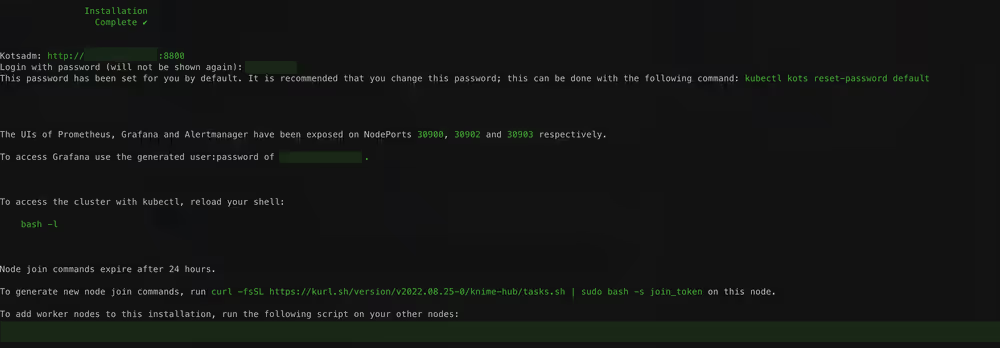
Next steps in the installation
Once the following supplemental steps above have been completed, you should be able to proceed with the remainder of the install.
The high-level remaining steps include:
- Logging into the KOTS Admin UI
- Uploading the Replicated license which will fetch the latest release of Business Hub
- Enter appropriate configuration parameters in the KOTS Admin Console
- Save the changes, allow the pre-flight checks to run, then click Deploy and Wait for the installation to complete.
Access the KOTS Admin Console
Navigate to the KOTS Admin Console URL and take note of the password.

The first page that will display is a warning regarding Transport Layer Security (TLS) configuration. Follow the on-screen instructions to proceed.

You will then be prompted to provide your own TLS cert to secure traffic to the admin console.
For everything to work correctly and securely, setting up TLS is strongly recommended.
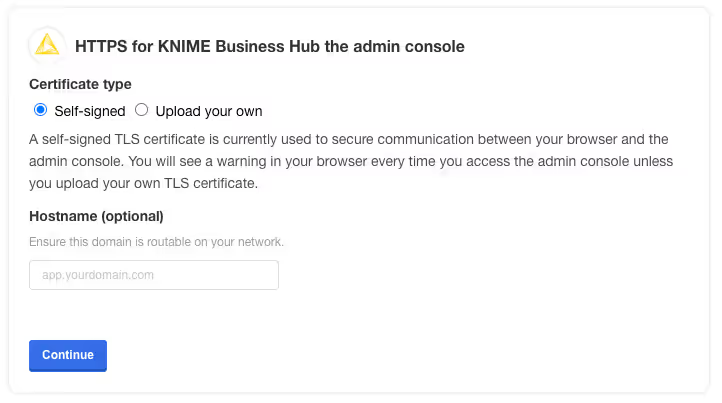
You should then see a prompt for a password. Enter the admin console password to proceed (this password can be changed later).

Provide a Replicated .yaml license file
After logging in, you should be prompted for a license file. This is the Replicated license file that your KNIME customer care representative has provided to you and has a .yaml extension. Please contact your customer care representative if you need assistance with your license.
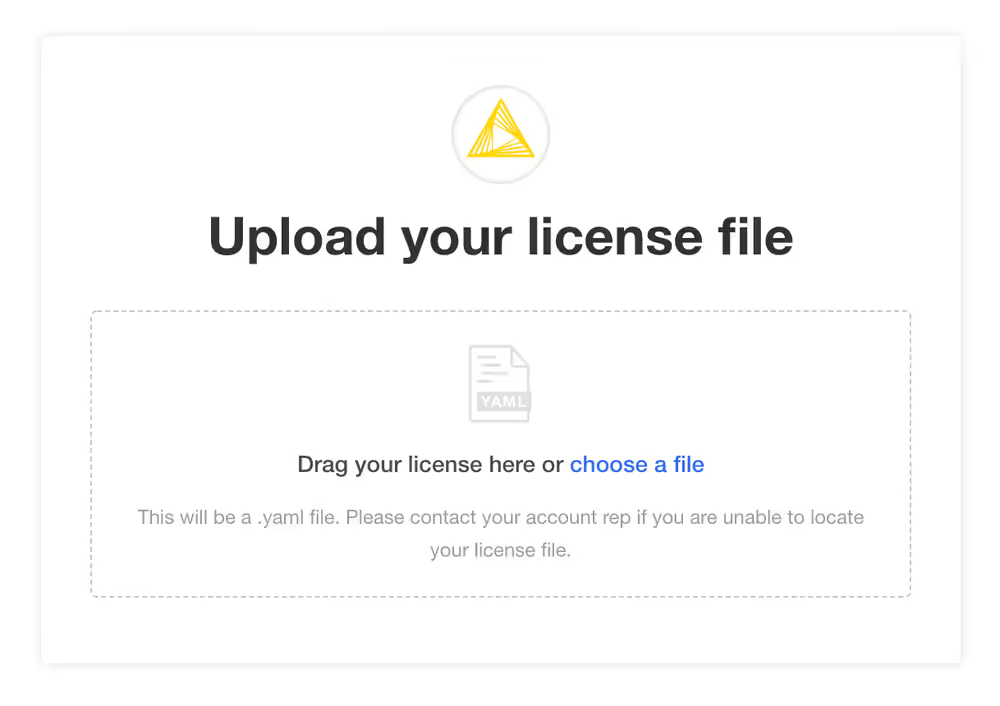
You may be prompted to install KNIME Business Hub into an “airgapped environment” if airgap installations are enabled on your license. This feature is particularly useful for installing KNIME Hub onto a machine that has no outbound internet access. Follow the instructions in the KNIME Business Hub airgapped installation section.
In most cases, it is fine to click the Download KNIME Hub from the Internet button if this prompt appears.
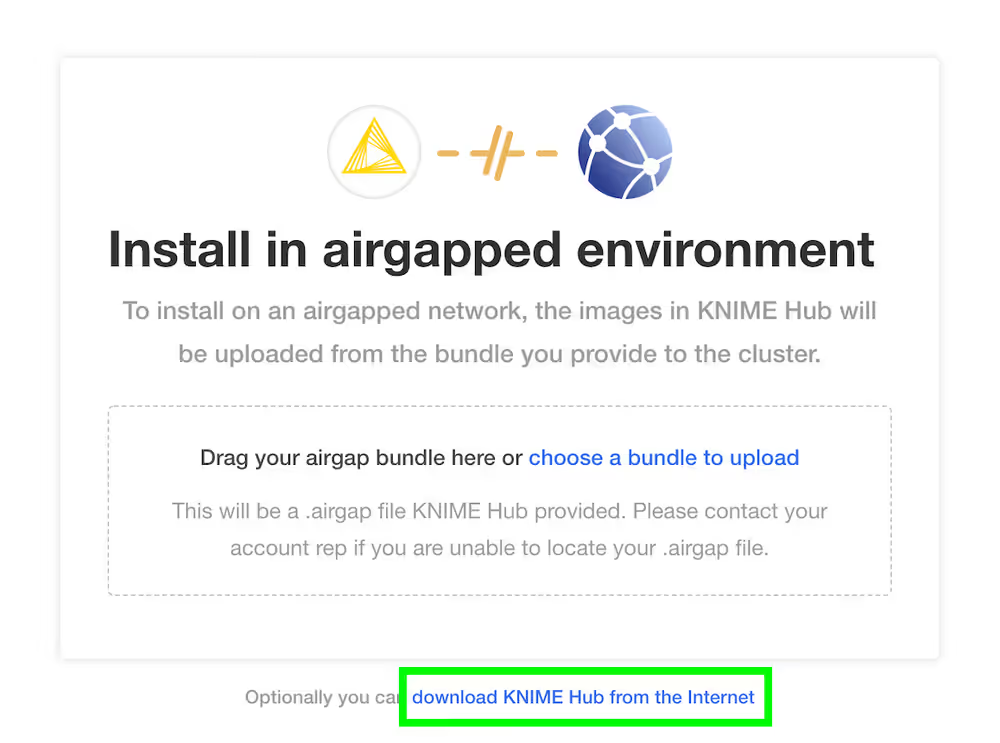
Configure the installation
If all prior steps were successful, you should now be prompted to configure your KNIME Business Hub installation. A number of settings will display for you to customize. Please note that all configuration settings in this view can be changed post-installation, except for the settings under “Initialization of KNIME Business Hub”.
Global overview
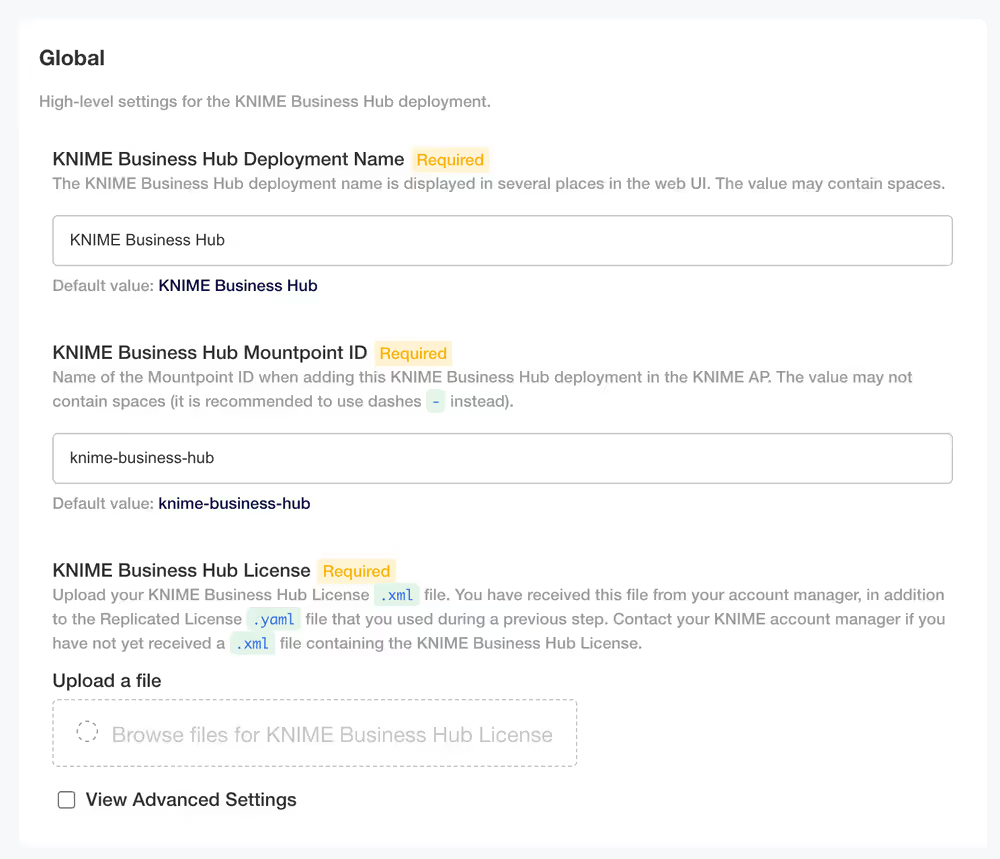
- KNIME Business Hub Deployment Name - This will be the name of your deployment for KNIME Business Hub
- KNIME Business Hub Mountpoint ID - This is where your KNIME Business Hub Mountpoint will be.
- KNIME Business Hub License - You should have received this from your account manager. This is a different file than the Replicated
.yamllicense file. The KNIME Business Hub license file is a.xmlfile that contains information needed for your installation. Upload it here by clicking Browse files for KNIME Business Hub License and navigating to the file on your local machine. - (OPTIONAL) select View Advanced Settings: - This will add additional fields underneath the Notifications section. This are explained in the Advanced options section.
Initialization of KNIME Business Hub
During the very first installation of KNIME Business Hub a number of one-time initializations are made, like creating an admin user, team, space, and execution context. Changing fields in this section after installation won’t have any effect on the deployed application. The admin user can change these after the installation in the browser.
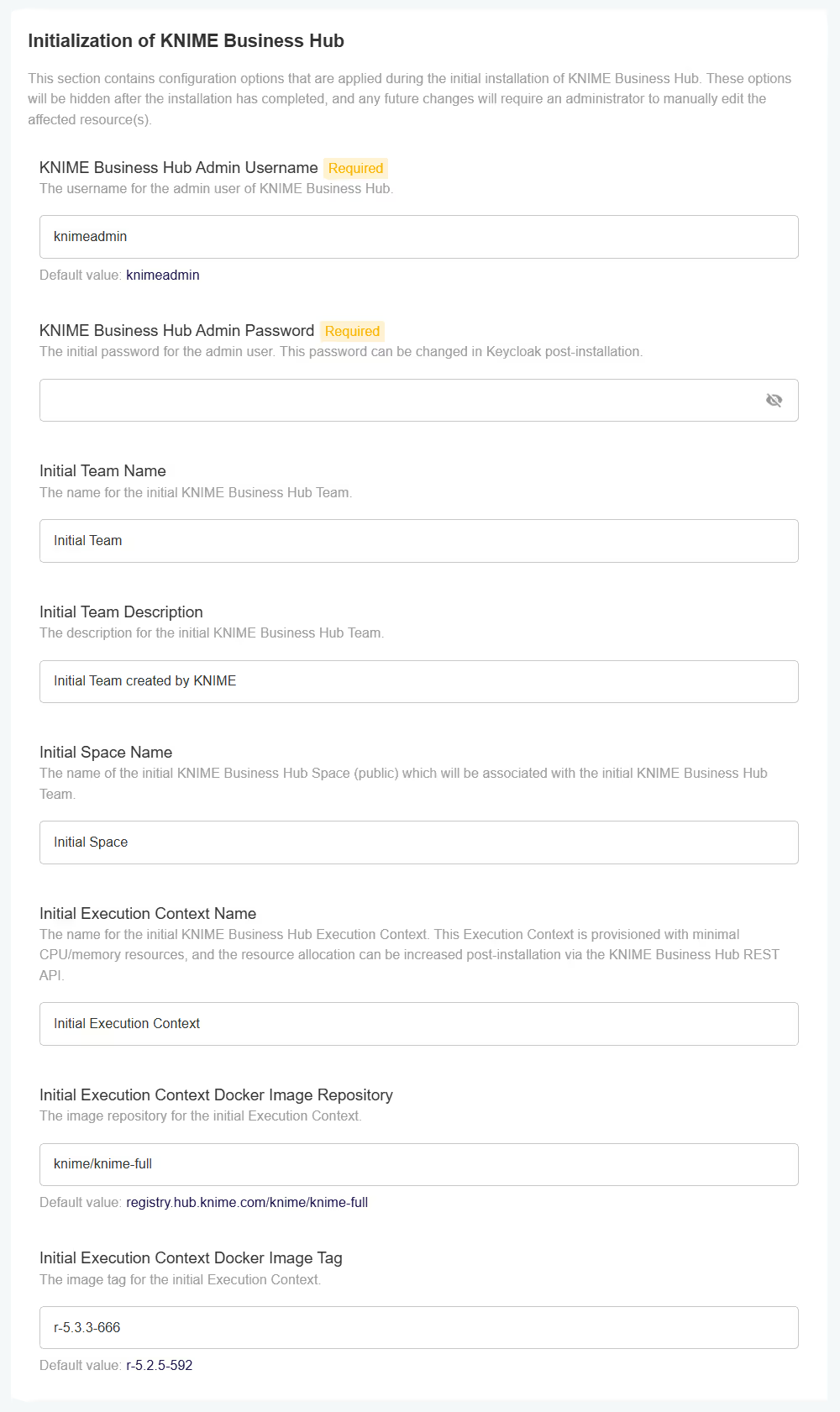
- KNIME Business Hub Admin Username - Choose a username for the KNIME Business Hub
- KNIME Business Hub Admin Password - Choose a password for the KNIME Business Hub
- Initial Team name - Choose a name for the initial team that KNIME Business Hub will create
- Initial Team description - Give a brief description of the Initial Team name
- Initial Space Name - This will be a public facing space name associated with the Initial Team Name
- Initial Execution Context Name - The name for the initial KNIME Execution Context Name
- Initial Execution Context Docker Image Repository - This is where the docker image link will go
- Initial Execution Context Docker Image Tag - This is where the initial Execution Context will go
There has been a change in the KNIME repository. In case it is pointing to registry.hub.knime.com/knime/knime-lts-full, shorten it to knime/knime-lts-full as shown in the screenshot. For a list of images and their tags from the KNIME repository, check the KNIME Business Hub Admin Guide.
The execution context has minimal resources (1CPU, 2GB memory) and a default executor provided by KNIME, to enable basic execution. For any production use of execution you should configure the execution context and assign more resources or use a different executor docker image.
Configure KNIME Business Hub URLs
URLs for KNIME Business Hub need to have the structure of:
Base URL
<base-url>(e.g.hub.example.com).The URL scheme (
http://orhttps://) should not be included in the Base URL.The
<base-url>must include the top-level domain (e.g..com), and cannot be an IP address.This is the URL you use to view the KNIME Business Hub in your browser.
Valid examples:
hub.example.comexample.com
Invalid examples:
[https://hub.example.com/](https://hub.example.com/)example.com/hubmyhub12.34.56.78
Subdomains
apps.<base-url>api.<base-url>ws.<base-url>auth.<base-url>storage.<base-url>registry.<base-url>
The Base URL is the only URL that can be customized. The rest of the URLs are generated automatically.
- Webapp URL - The URL to the KNIME Business Hub webapp
- DataApps URL - The URL for the KNIME Business Hub DataApps
- API URL - The URL to the KNIME Business Hub API
- Websocket URL - The URL to the KNIME Business Hub Websocket
- Authentication URL - The URL to the KNIME Business Hub authentication endpoint
- Storage URL - The URL to the KNIME Business Hub persistent storage endpoint
- Registry URL - The URL to the KNIME Business Hub Embedded registry endpoint
If you are testing KNIME Business Hub without DNS configured, it is recommended to create /etc/hosts entries on your local machine pointing to the public IPv4 address of the instance running the cluster. This will redirect traffic from your local machine to the appropriate IPv4 address when you enter URLs such as http://hub.example.com/ into your browser.
Notice that the values in /etc/hosts below are for hub.example.com. The values must match the config in the URLs section of the Config tab in the KOTS Admin Console, as demonstrated above. You can always use hub.example.com as the Base URL for local test installations.
<public ip> hub.example.com
<public ip> api.hub.example.com
<public ip> auth.hub.example.com
<public ip> storage.hub.example.com
<public ip> apps.hub.example.com
<public ip> registry.hub.example.com
<public ip> ws.hub.example.comOn Windows machines you can find the /etc/hosts file in <windows dir>\system32\drivers\etc\hosts.
Branding
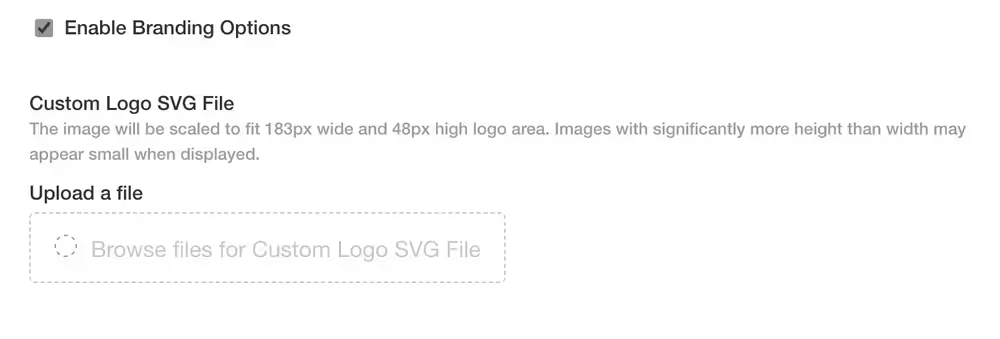
If you would like to have branding options enabled check the Enable Branding Options box.
You will now be able to upload your own logo. Click Browse files for Custom Logo SVG File and navigate to select the file from you local machine.
If customizing the logo, the file being uploaded must be an .svg file in XML format such as the one below.
example.svg
html
<?xml version="1.0" encoding="UTF-8" standalone="no"?>
<!DOCTYPE svg PUBLIC "-//W3C//DTD SVG 1.1//EN" "http://www.w3.org/Graphics/SVG/1.1/DTD/svg11.dtd">
<svg
width="100%"
height="100%"
viewBox="0 0 183 48"
version="1.1"
xmlns="http://www.w3.org/2000/svg"
xmlns:xlink="http://www.w3.org/1999/xlink"
xml:space="preserve"
xmlns:serif="http://www.serif.com/"
style="clip-rule:evenodd;fill-rule:evenodd;stroke-linejoin:round;stroke-miterlimit:2;"
>
<g transform="matrix(0.673983,0,0,0.673983,-2.4399,8.02946)">
<text
x="6.739px"
y="43.245px"
style="font-family:'Arial-BoldMT', 'Arial', sans-serif;font-size:54.619px;font-weight:700;"
>
EXAMPLE
</text>
</g>
</svg>Execution Image Builder

Here you can configure the Execution Image Builder to build custom execution Docker images and push them to the embedded registry or to an external registry.
If you check the Enable Execution Image Builder box, two additional fields will appear.
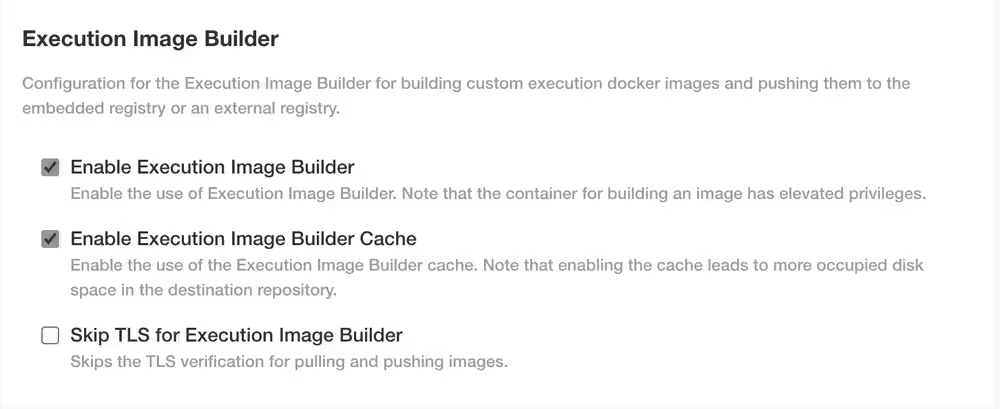
By default Enable Execution Image Builder Cache will be selected. The option Skip TLS for Execution Image Builder skips the TLS verification for pulling and pushing images to the registry.
Execution Contexts
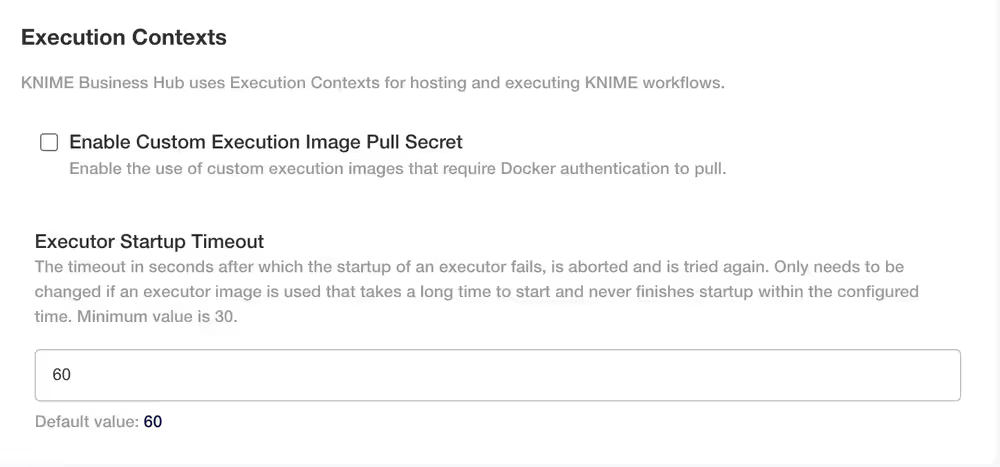
By default Enable Custom Execution Image Pull Secret is unchecked. By checking it you will get another option that will appear:

- Execution Image Pull Secret Name - The name of the Kubernetes Secret resource which contains the Docker image pull secret for custom execution image(s).
- Executor Startup Timeout - The timeout in seconds after which the startup of an executor fails, is aborted and is tried again
Job Instrumentation Data

- Select the box Do you want to collect job instrumentation data? to allow the KNIME Business Hub instance to collect data about workflows execution.
- Job Info Expiration - This number reflects how long the instrumentation data about a job is stored in days
Configure networking
In the section Networking of the Admin Console you can deploy an external load balancer and enable and configure the Transport Layer Security (TLS).
It is anyways possible to configure this section in a second step.
To have more information on how to configure the networking section read the KNIME Business Hub Admin Guide.

Notifications
In this section you can configure the notification service, which notifies for various events.
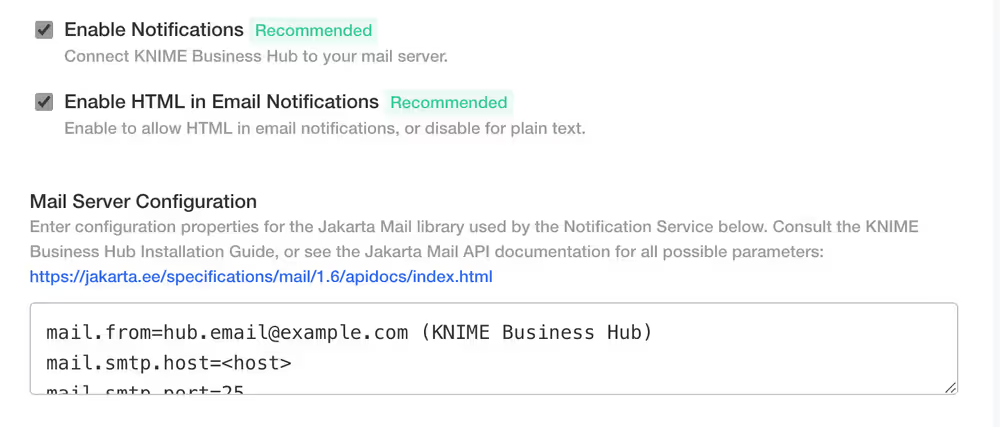
By enabling the Enable Notifications box you get a new option that is checked by default.
Enable HTML in Email Notifications - allows HTML in email notifications, or disable this option for plain text
Mail Server Configuration - Enter configuration properties for the Jakarta Mail library
You can consult the Jakarta Mail API documentation for all possible parameters in the Jakarta Mail API documentation.
The default code value is as follows:
| Name | Value | Description |
|---|---|---|
mail.from | hub.email@example.com | Address from which all mails are sent, required |
mail.smtp.host | <host> | SMTP server host address |
mail.smtp.port | 25 | SMTP port, default 25 |
mail.smtp.auth | true | Set to true if the mail server requires authentication |
mail.smtp.user | <user> | Username for SMTP authentication; optional |
mail.password | <password> | Password for authentication; optional |
mail.smtp.starttls.enable | false | If true, enables the use of the STARTTLS command (if supported by the server) to switch the connection to a TLS-protected connection before issuing any login commands. |
mail.smtp.ssl.enable | false | If set to true, use SSL to connect and use the SSL port by default. |
Embedded Docker Registry
The Embedded Docker Registry is only available on the kURL embedded cluster.
To execute workflows on KNIME Business Hub the users will need to have access to an execution context. The execution context is based on a Docker image containing a KNIME executor with specific extensions and assigned vCores and RAM.
KNIME provides a public registry from which is possible to get standard Docker images to build execution context running on a specific executor version. However, there might be cases in which a team or user might need specific extensions that are not available in the Docker images provided in the KNIME public registry.
Enabling the Embedded Docker Registry will make it available at the following URL, defined in the KNIME Business Hub URLs section:
`registry.<base-url>`e.g. registry.hub.example.com.
Once a custom Docker image is created, as shown in the Docker executor images section of the KNIME Business Hub Admin Guide, it can be pushed to the Embedded Docker Registry. The images present in the registry are then available to be used to create an execution context.

- Embedded Registry Username - The default value for Embedded Registry Username is
knime - Embedded Registry Password - Choose a password for the Embedded Registry
Please note that, in order to avoid important images, needed for the correct functioning of the Business Hub instance, to be auto-removed from the Embedded Docker Registry, the image garbage collection can be disabled as described in the Replicated documentation.
Preflight checks
The final step before installing is the preflight checks, which is a set of automated tests to help identify if KNIME Business Hub is ready for installation. It will check the Kubernetes distribution, Kubernetes version, resources available to the cluster, and other mission-critical settings.
It is highly recommended to never skip the pre-flight checks during installation or upgrades.
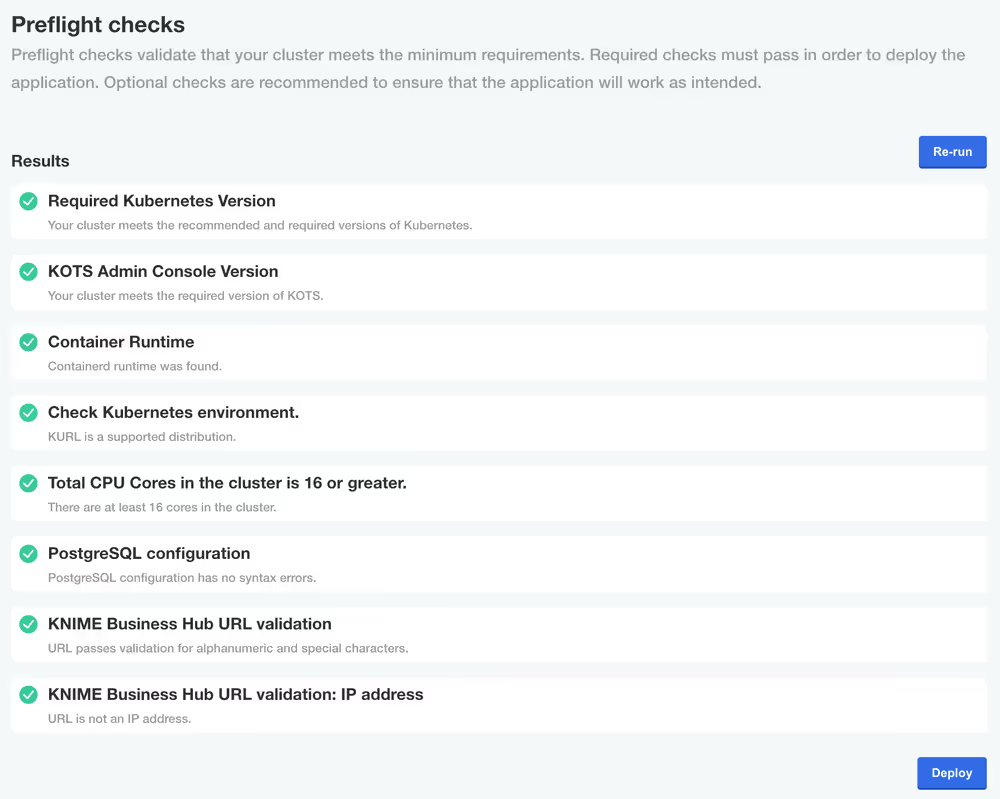
Wait for the installation to complete
If the preflight checks all passed and you opted to continue, the only thing left to do is wait for a few minutes until KNIME Hub finishes installing! You should see the installation turn the Ready status (top left) to green after 15-20 minutes.
If you cannot access the KNIME Business Hub Webapp URL after the Ready status has turned green, the first troubleshooting step would be to check the Config tab in the KOTS Admin Console and ensure the URLs are configured properly.
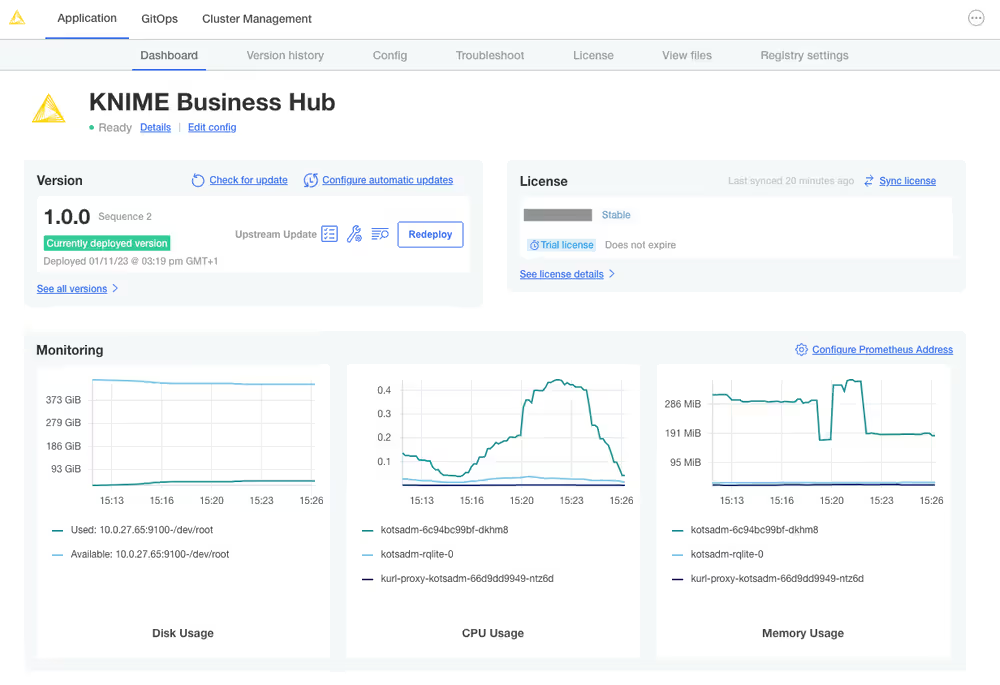
Navigating to the Webapp URL should display the KNIME Business Hub landing page.
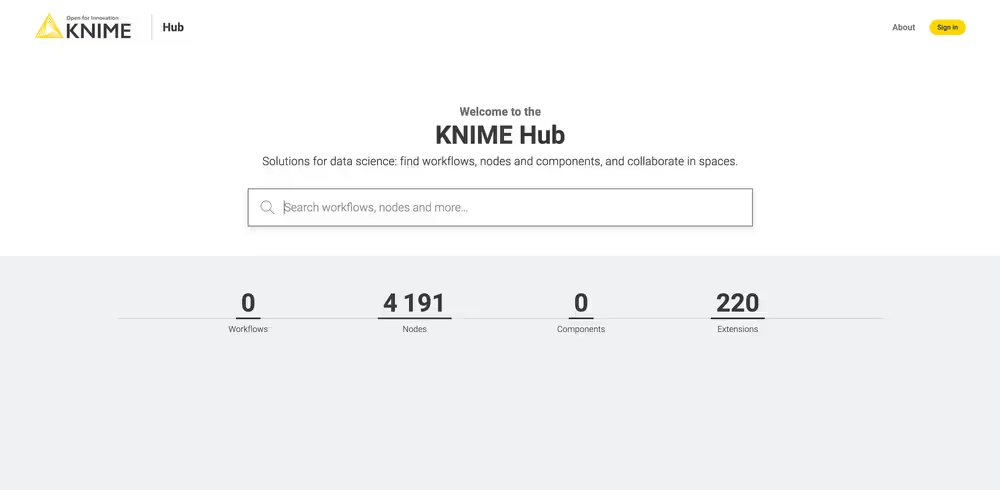
KNIME Business Hub airgapped installation (single-node)
Airgap install
The term airgap is used to indicate a computer network environment that has no external network access. This type of networking environment is useful for securing sensitive data, applications, and computing resources.
An airgap environment may be completely isolated or have a firewall between it and other networks with wider access. That wider access may be to the external world or within the wider organization.
Installing modern software in an airgap environment can be challenging. Containerization and public registries for container images work on the assumption that all software installs have access to the public internet. To get around this challenge, software installs have to package all the required artifacts and images into a bundle that can be copied to portable media for transport into the airgap environment.
The KNIME Business Hub supports installation into environments with externally accessible networks and into airgap environments. Of course airgap environments require an airgap install approach. But even networks with external access may require airgapped installations. For instance, many organizations do not allow downloading container images from public image registries. In this instance, an airgap install will be required.
The airgap install process described in this section is for a single-node installation.
Getting started
To get started with an airgap install you will need the link to the Download Portal of Replicated and a password that you will receive from your KNIME customer care representative.
Enter the Download Portal from a machine that has access to the internet and has also access to the installation machine.
Here, you need to select the type of installation that you need to perform. Select "Embedded cluster" option so that the installation process will also install Kubernetes cluster along with the KNIME Business Hub.
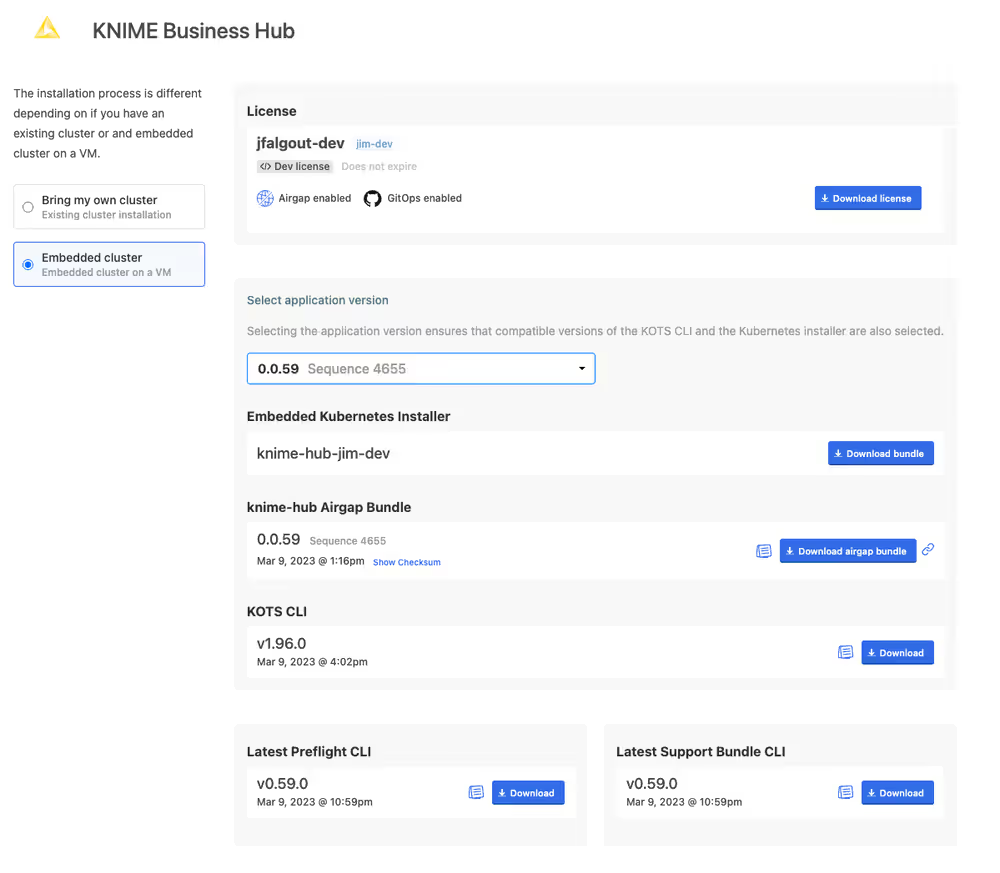
From the download page you need to download:
- The Replicated license file (
.yaml) with airgap install enabled. - The airgap bundle for the KNIME Business Hub (knime-hub Airgap Bundle).
- Finally, you will need kURL bundle to install the kURL distribution of Kubernetes. This means you need to download the Embedded Kubernetes installer bundle.
Getting Kubernetes ready
Next step is to install a new Kubernetes cluster on your machine. KNIME supports the kURL distribution of Kubernetes.
This distribution is installed into a single machine and also supports extending to a cluster of machines.
Increase the limit for allowed open files
In single-node installations the limit for allowed open files needs to be increased on the host VM for Business Hub to function properly.
We recommend to increase the limit by running the following command on the host VM.
BASH
sudo sysctl fs.inotify.max_user_instances=8192This value needs to be set again after VM restarts. Alternatively you can persist it by adding it to /etc/sysctl.conf.
If the limit was not increased you might encounter the following error, appearing after the Business Hub installation is completed. In this case the istio-proxy container in the keycloak-proxy and s3-proxy pods isn’t able to start up with a "too many open files" error.
An example error log can be seen below. Replace keycloak-proxy-7ff44f845f-jrh9s with an appropriate pod id in your cluster.
bash
$ kubectl logs -n hub keycloak-proxy-7ff44f845f-jrh9s -c istio-proxy
{"level":"fatal","time":"2023-03-01T22:07:13.738069Z","msg":"Agent start up errorfailed to start workload secret manager too many open files"}Installing kURL
kURL is a Kubernetes distribution supported by KNIME Business Hub. If you do not have an existing Kubernetes cluster, then kURL can be used as the deployment cluster for KNIME Business Hub.
The kURL install bundle is required to install and deploy a Kubernetes instance to a single VM.
To download the kURL bundle go to the link to the Download Portal you received from your KNIME customer care representative, and download the Embedded Kubernetes Installer (knime-hub.tar.gz).
You will also need to create a file patch.yaml that looks like the following:
yaml
# This is an example patch file to override the Kurl MinIO object store's size. This should
# be sized larger for airgap installs or when using the embedded registry to ensure adequate
# disk is available. The default size is 10GB if not overridden.
apiVersion: cluster.kurl.sh/v1beta1
kind: Installer
metadata:
name: "knime-hub-installer-patch-minio-size"
spec:
MinIO:
claimSize: "30Gi"This is to ensure that enough storage is allocated for the MinIO object store used for staging/storing artifacts. By default, the Kurl MinIO object store is only 10GB, which is likely to fill up very quickly for airgap installations so you need to use the patch.yaml file to override the size setting at install.
Copy the downloaded bundle knime-hub.tar.gz and the patch.yaml to the target machine and run the following commands:
tar xvzf knime-hub.tar.gz
cat install.sh | sudo bash -s airgap installer-spec-file="./patch.yaml"
bash -lThe output of the command will contain the KOTS Admin Console URL and password. Look for these lines in the command output and copy the values:
Kotsadm: http://10.0.102.215:8800
Login with password (will not be shown again): <password>The kotsadm password can be changed using the command:
kubectl kots reset-password defaultThe kotsadm password will be required when installing the KNIME Business Hub in this Kubernetes cluster.
Installing KNIME Business Hub
Once your Kubernetes cluster is installed and configured with the KOTS extension, you are ready to install the KNIME Business Hub.
Now you need to proceed with the airgap install on a machine that:
- Hosts the web browser used for the install and has access to the internet
- Has access to the machine into which you are installing your KNIME Business Hub instance
On the machine that can access the installation machine, you can open the KOTS Admin Console URL and enter the kotsadm password. Follow the instructions for installing the KNIME Business via a browser. You will first need to upload the license and then the airgap bundle you downloaded from the Download Portal.
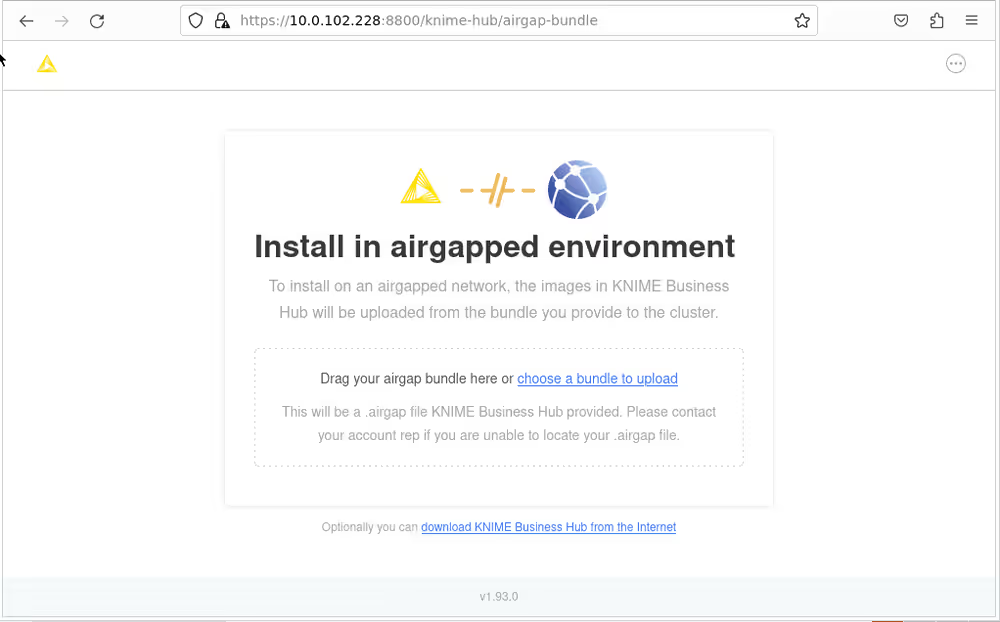
Once you select the KNIME Business Hub airgap bundle to use, the bundle will be uploaded to the install computer. The bundle is large and will take some time to upload.
Once the bundle has completed loading, the installer will extract all the required images from the bundle and store them in a local image registry. Again this will take some time. In your browser, you will see the progress of the extraction and load process. It will look like the screen shot below. Once the load into the registry is complete, the configuration page will be shown. Proceed as normal with the install at this point.
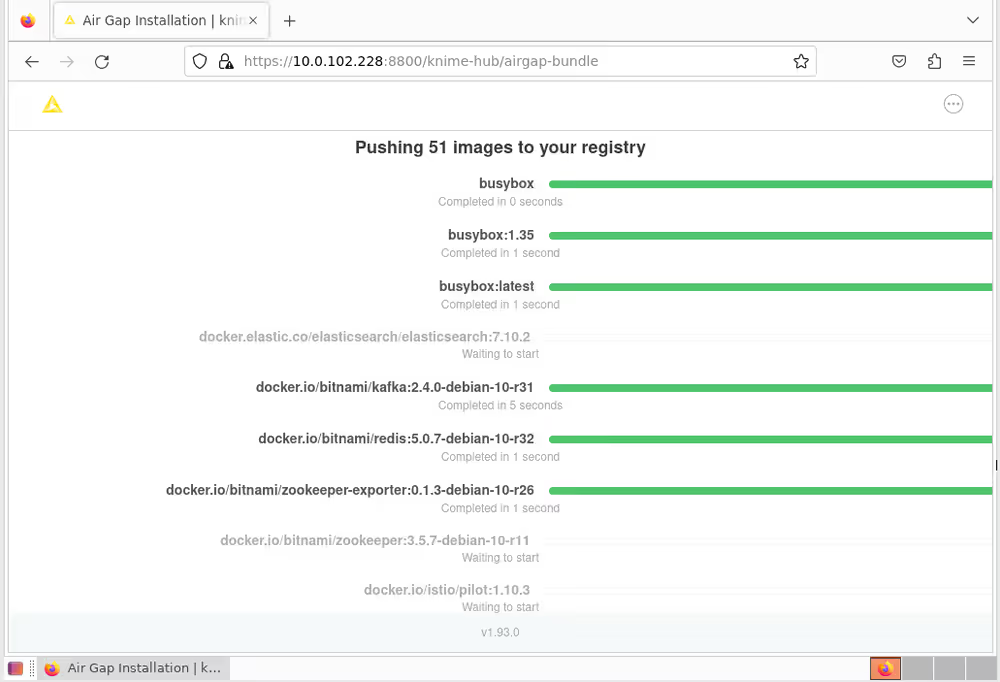
If all prior steps were successful, you should now be prompted to configure your KNIME Business Hub installation.
To do so follow the steps in the Configure the installation section.
Advanced installation types
This section covers advanced installation topics for detailed networking requirements, and other environmental considerations.
Installations with multiple nodes
This section covers the requirements for multi-node installations of KNIME Business Hub. It is important to note that the recommended set up for multi-node installations is to have a single primary node and one or more secondary nodes for execution. We do not support HA (High Availability) for embedded cluster installations.
Find documentation on how to join nodes to a cluster here: Replicated: Cluster Management - Add Nodes
Hardware prerequisites
Here we provide installation requirements for multi-node installations.
Primary node
The primary node needs to have at least:
- 16 vCores
- 32 GB RAM
Disk: 500GB+ for the root volume.
This is the minimum size for the root volume, which is used to store the persistent components of Business Hub, such as databases, data files for workflows, logs, and execution context images.
Getting a larger root volume is recommended, depending on the expected usage of the Business Hub.
Secondary nodes
The secondary nodes need to be adjusted based on the expected execution load.
Contact KNIME Support for guidance on sizing secondary nodes.
Networking requirements
Firewall openings for online installations
The following domains need to be accessible from servers performing online kURL installs. IP addresses for these services can be found in replicatedhq/ips.
| Host | Description |
|---|---|
*.amazonaws.com | tar.gz packages are downloaded from Amazon S3 during embedded cluster installations. The IP ranges to allowlist for accessing these can be scraped dynamically from the AWS IP Address Ranges documentation. |
k8s.gcr.io | Images for the Kubernetes control plane are downloaded from the Google Container Registry repository used to publish official container images for Kubernetes. For more information on the Kubernetes control plane components, see the Kubernetes documentation. |
k8s.kurl.sh | Kubernetes cluster installation scripts and artifacts are served from kurl.sh. Bash scripts and binary executables are served from kurl.sh. This domain is owned by Replicated, Inc which is headquartered in Los Angeles, CA. |
No outbound internet access is required for airgapped installations.
Host firewall rules
The kURL install script will prompt to disable firewalld. Note that firewall rules can affect communications between containers on the same machine, so it is recommended to disable these rules entirely for Kubernetes. Firewall rules can be added after or preserved during an install, but because installation parameters like pod and service CIDRs can vary based on local networking conditions, there is no general guidance available on default requirements. See Advanced Options for installer flags that can preserve these rules.
The following ports must be open between nodes for multi-node clusters:
| Protocol | Direction | Port Range | Purpose | Used By |
|---|---|---|---|---|
| TCP | Inbound | 6443 | Kubernetes API server | All |
| TCP | Inbound | 2379-2380 | etcd server client API | Primary |
| TCP | Inbound | 10250 | kubelet API | Primary |
| UDP | Inbound | 8472 | Flannel VXLAN | All |
| TCP | Inbound | 6783 | Weave Net control | All |
| UDP | Inbound | 6783-6784 | Weave Net data | All |
| TCP | Inbound | 9090 | Rook CSI RBD Plugin Metrics | All |
| TCP | Inbound | 31880 | OpenEBS to Rook migration during setup | Primary |
Secondary Nodes:
| Protocol | Direction | Port Range | Purpose | Used By |
|---|---|---|---|---|
| TCP | Inbound | 10250 | kubelet API | Primary |
| UDP | Inbound | 8472 | Flannel VXLAN | All |
| TCP | Inbound | 6783 | Weave Net control | All |
| UDP | Inbound | 6783-6784 | Weave Net data | All |
| TCP | Inbound | 9090 | Rook CSI RBD Plugin Metrics | All |
These ports are required for Kubernetes and Weave Net.
Available ports
In addition to the ports listed above that must be open between nodes, the following ports should be available on the host for components to start TCP servers accepting local connections.
| Port | Purpose |
|---|---|
| 2381 | etcd health and metrics server |
| 6781 | weave network policy controller metrics server |
| 6782 | weave metrics server |
| 10248 | kubelet health server |
| 10249 | kube-proxy metrics server |
| 9100 | prometheus node-exporter metrics server |
| 10257 | kube-controller-manager health server |
| 10259 | kube-scheduler health server |
Installation on hosts with undersized root volumes
By default, the Kurl embedded cluster uses OpenEBS for volume provisioning, which leverages the hosts disk for persistence. This location defaults to /var/openebs/local. Additionally, the host disk is used for caching container images and other artifacts.
If the host disk does not have sufficient capacity for installation, an additional disk can be mounted and configured for use.
Follow the recommended best practice for your hardware, infrastructure provider and Linux distribution to add a new disk and ensure a partition and filesystem have been created on it and that it is mounted.
The following steps can then be used to configure that disk for persistence with KNIME Business Hub.
Set up new directories and symlinks
The disk should be mounted to /var/lib/replicated. Once that is done, the following will create and link additional needed directories.
bash
mkdir /var/lib/replicated/kubelet
ln -s /var/lib/replicated/kubelet /var/lib/kubelet
mkdir /var/lib/replicated/openebs
ln -s /var/lib/replicated/openebs /var/openebs
mkdir /var/lib/replicated/containerd
ln -s /var/lib/replicated/containerd /var/lib/containerd
mkdir /var/lib/replicated/kurlUpdate installer script
Next, download the installer script, but don’t execute it.
bash
curl -sSL https://kurl.sh/knime-hub > kurl-installer.shInside the installer script is a line starting with Environment="KUBELET_CONFIG_ARGS=, which specifies flags to be passed to the kubelet process that runs on the node. An additional flag (--root-dir) needs to be appended to these arguments to point to /var/lib/replicated/kubelet.
This line in the installer script can be manually updated, or the following sed command can be run to automatically apply the change.
bash
sed -i 's/\/var\/lib\/kubelet\/config\.yaml/\/var\/lib\/kubelet\/config\.yaml --root-dir=\/var\/lib\/replicated\/kubelet/g' kurl-installer.shOnce edited, the complete line should look like the following:
bash
Environment="KUBELET_CONFIG_ARGS=--config=/var/lib/docker/kubelet/config.yaml --root-dir=/var/lib/replicated/kubelet"Install Kurl with argument overrides
To complete the install, chmod is used to make the shell script executable, then the script is executed with any needed arguments.
The kurl-install-directory="/var/lib/replicated/kurl" argument must be specified. Other arguments can additionally be added as needed. Note that, unlike standard install command which uses curl to download the installation script and pipe it directly into a bash shell, the -s flag is not needed before specifying arguments when the script is directly executed.
bash
chmod +x kurl-installer.sh
./kurl-installer.sh kurl-install-directory="/var/lib/replicated/kurl"Post-installation steps
Version updates
If you save any changes in the Config tab of the KNIME Business Hub Admin Console, or check for updates and see a new version that you can upgrade to, then the new version will be visible in the Version history tab. New versions of KNIME Business Hub will not be deployed automatically unless automatic updates have been configured. Preflight checks will execute prior to deployment and the deployment itself can be triggered by clicking the Deploy button.
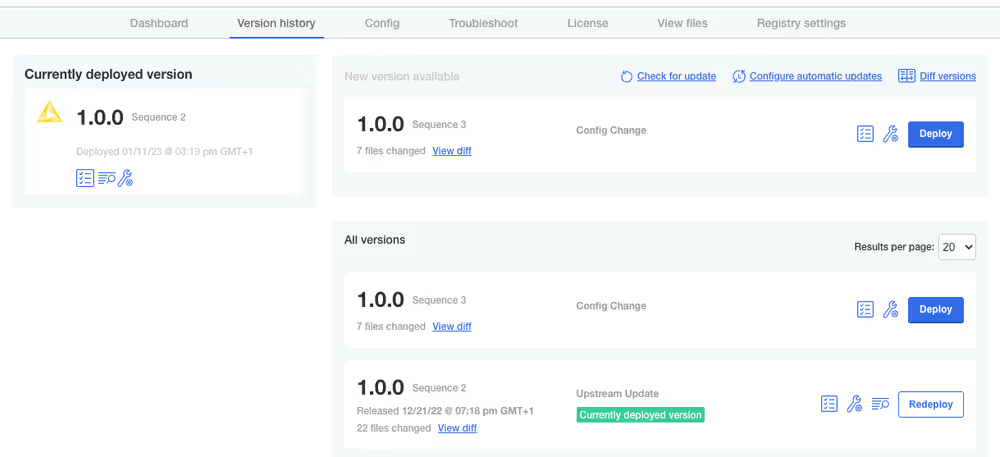
User registration
After initial installation, start the process of creating the first user by clicking the Sign In button.
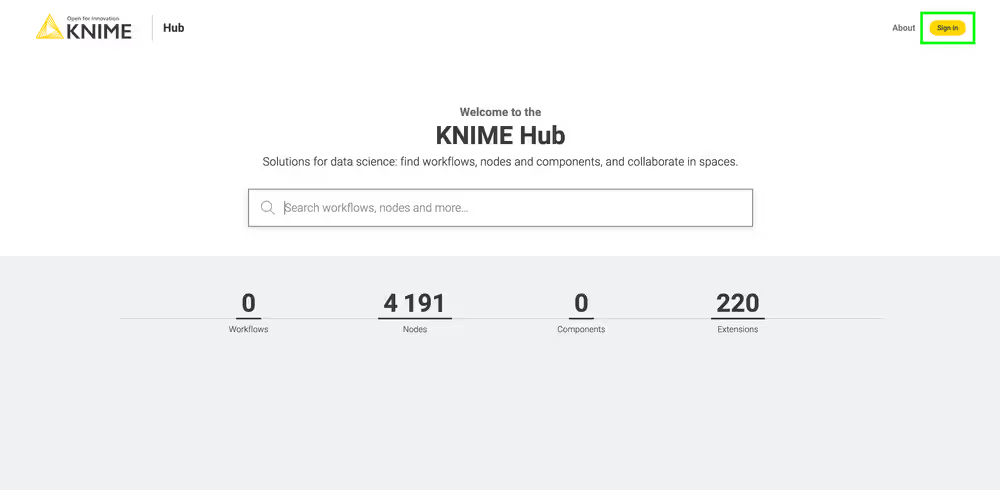
Next, click the Register button to proceed with creating a new account. You will be prompted for user information and will be logged in automatically.
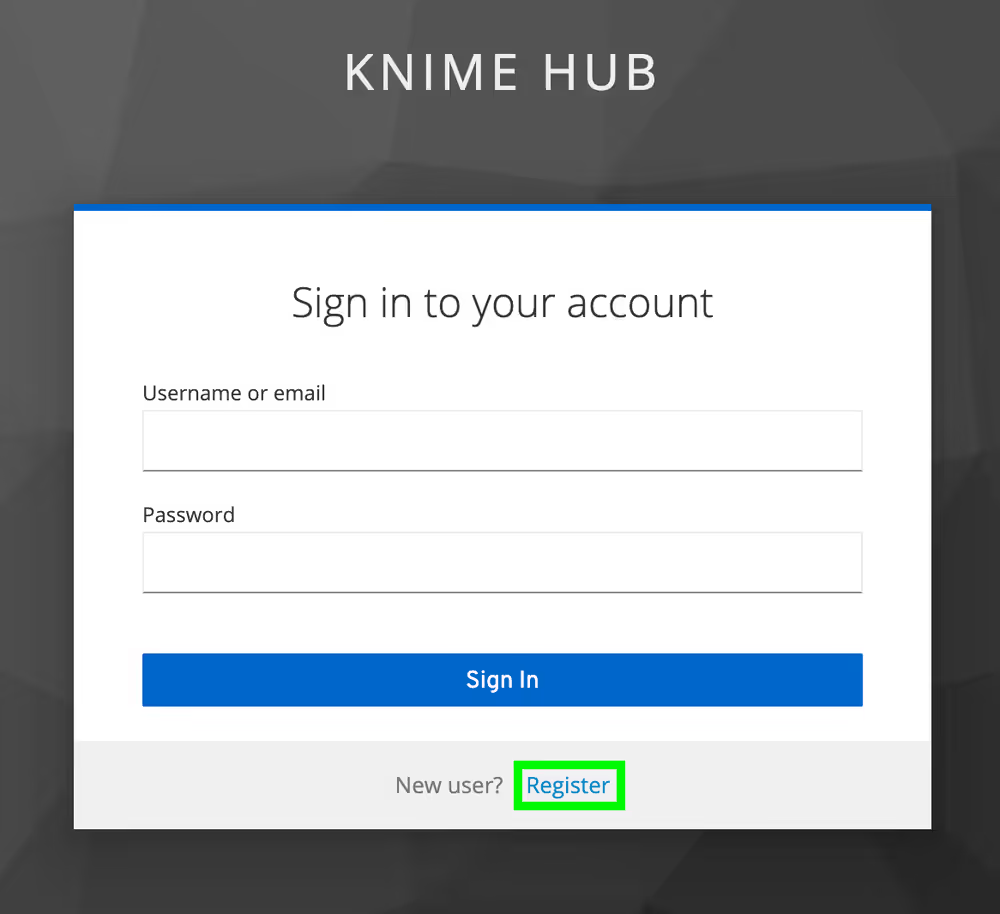
Users can change their password by going to auth.<base-url>/auth/realms/knime/account (e.g. http://auth.hub.example.com/auth/realms/knime/account) and navigating to Account Security → Signing In.

Keycloak setup
Keycloak is an open source software product that KNIME Business Hub leverages for authenticating users with Single-Sign On. Keycloak offers Identity Brokering and User Federation to external Identity Providers.
You can manage your Keycloak setup by going to auth.<base-url>/auth/ (e.g. http://auth.hub.example.com/auth/), clicking Administration Console and logging in with the Keycloak admin credentials. These credentials are stored in a kubernetes secret called credential-knime-keycloak in the <business-hub-namespace> namespace.
You can perform the steps here to retrieve the Keycloak credentials at any time.
When you first log in to the Keycloak Administration Console you are shown the
masterrealm. However, all KNIME Business Hub related configurations are in theknimerealm. You can select the realm via the dropdown menu in the top left corner.
For configuring your Keycloak setup, e.g.for adding User Federation or an external Identity Providers, consult the Keycloak Server Administration Guide.
Integrating an external Identity Provider (IdP)
While Keycloak itself can be used as the user base, KNIME Business Hub can also federate to an external IdP. To do this the external IdP needs to support a protocol known to Keycloak, such as SAML v2.0, OpenID Connect v1.0, or OAuth v2.0. For configuring Keycloak to use an external IdP please see the Integrating identity providers section in Keycloaks own documentation on this topic.
If you are using Microsoft Entra ID as external Identity Provider you can restrict who can register to your KNIME Business Hub instance by deactivating the option "Assignment required?" in Microsoft Entra ID to Yes and then allowing only a subset of users or groups to access the KNIME Business Hub instance as explained in the Microsoft Entra ID documentation.
Requirements
Keycloak and KNIME Business Hub have the following requirements for a user or external Identity Provider:
Usernames can only include letters and numbers as first character. Letters, numbers, underscore, and @ as last character. Letters, numbers, space, dot, underscore, hyphen, and @ for remaining characters. The minimum length is 3 characters, the maximum is 64. Special characters like umlauts (äöü) are not allowed.
- KNIME Business Hub uses this regex to validate usernames:
^[a-zA-Z0-9][a-zA-Z0-9-_.@ ]{1,62}[a-zA-Z0-9_@]$.
- KNIME Business Hub uses this regex to validate usernames:
When a new user is added to keycloak, it needs to have values for the Username, Email, First name and Last name fields. If any of those are not filled in automatically you need to create a mapper for it in the Identity Provider settings. Otherwise the user will be prompted to fill in details themselves when they log in for the first time.
Each user needs to have an email address, even if notifications are not configured in KNIME Business Hub.
Identity Provider Mapper
After adding an external IdP to your Keycloak instance you can create Identity Provider Mappers. These mappers can be used to fill in attributes if they are not getting automatically added, like Email. See the Mapping claims and assertions section in Keycloaks documentation.
In Keycloak, in the knime realm, go to the Identity Providers section, click your provider and go to the Mappers tab. Click the Add Mapper button and configure the mapper. Some useful Mapper types:
Username Template Importer: you can use this mapper to generate a username from multiple claims if a username claim is not available. Example template:
${CLAIM. given_name}.${CLAIM.family_name}.given_nameandfamily_nameare the given claims here. Nesting is possible with e.g.${CLAIM.user_info.given_name}.- There are three transformers you can use here:
lowercase,uppercase, andlocalpart.
- There are three transformers you can use here:
Attribute Importer: map an Identity Provider claim to a Keycloak attribute. Useful target attributes:
email(Email),given_name(First name), andfamily_name(Last name). The Claim field is not a template like above, but accepts the claim name directly, e.g.family_name.Use the Hardcoded Attribute mapper if an attribute can’t be constructed from a claim.
For finding available claims see the section below.
Tips for debugging Keycloak when integrating an external IdP
To create appropiate mappers in the IdP configuration one needs to know what the external IdP is actually returning to Keycloak in the token. This can be done by increasing the loglevel of the org.keycloak.social.user_profile_dump keycloak logger to debug. To do so you need to modify an instance of the keycloaks.k8s.keycloak.org CustomResource. You can get the current yaml definition of it by executing:
bash
kubectl get keycloaks.k8s.keycloak.org -n knime knime-keycloak -o yamlYou can either save this output to a file, modify the file, and apply the changes to the cluster with:
bash
kubectl apply -f <file>Or you can edit it directly in the cluster using kubectl edit. This will open the default editor in your current shell. Make the modification, save and exit the editor, and it will automatically be applied to the cluster:
bash
kubectl edit keycloaks.k8s.keycloak.org -n knime knime-keycloakbash
kubectl edit keycloaks.k8s.keycloak.org -n knime knime-keycloakThe modification that needs to be done is adding an additonal configuration option under spec.additionalOptions:
bash
spec:
additionalOptions:
- name: log-level
value: INFO,org.keycloak.social.user_profile_dump:debugDo not remove or change any of the other lines.
After this modification has been applied the keycloak-operator will automatically reconcile the knime-keycloak-0 pod in the <business-hub-namespace> namespace. After the pod is ready again attempt a login with the configured external IdP in the KNIME Business Hub UI (e.g.[http://hub.example.com](http://hub.example.com)) and look at the log output of the knime-keycloak-0 pod. The interesting lines contain org.keycloak.social.user_profile_dump with the full JSON that was received from the external IdP:
2024-05-23 08:45:21,103 DEBUG [org.keycloak.social.user_profile_dump] (executor-thread-2) User Profile JSON Data for provider oidc: {"sub":"02aebee3-aaba-4e96-86a7-1d12531e8fb2","email":"admin@example.com","email_verified":false,"name":"Admin Admin","preferred_username":"admin","zoneinfo":"Europe/Berlin"}To turn the debug logging off again in Keycloak, remove the additionalOptions item that you added in the earlier step.
Update your KNIME Business Hub license
In order to deploy a new Business Hub license, please go to the Replicated console. There, navigate to the Config tab and find your current license file.
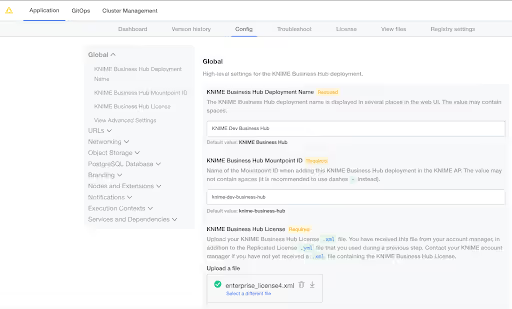
Click “select a different file”, and choose the .xml file provided by your KNIME customer care representative. Afterwards, scroll all the way to the bottom to confirm the configuration change. Click “go to updated version” next. This brings you to the “version history”, where you need to click on “deploy” to switch to the new license.

Connecting kubectl or other external tools to your cluster
Executing the following command on the Ubuntu instance in which KNIME Business Hub is installed will output the kubeconfig file which is required for accessing your cluster from another machine.
Sometimes the KUBECONFIG environment variable is not set automatically after installation. Running bash -l will reload the shell and likely solve the issue. Otherwise, you can run kubectl config view --raw which is equivalent to cat $KUBECONFIG.
bash
cat $KUBECONFIGNote that the .clusters[0].cluster.server property is almost certainly set to the private IPv4 address of the cluster (incorrect) and not the public IPv4 address (correct). Update the property to match the public IPv4 address of the Ubuntu instance hosting KNIME Business Hub.
apiVersion: v1
clusters:
- cluster:
certificate-authority-data: ...
server: https://<replace-with-public-ip>:6443
name: kubernetes
contexts:
- context:
cluster: kubernetes
user: kubernetes-admin
name: kubernetes-admin@kubernetes
current-context: kubernetes-admin@kubernetes
kind: Config
preferences: {}
users:
- name: kubernetes-admin
user:
client-certificate-data: ...
client-key-data: ...Uninstalling KNIME Business Hub
Uninstalling KNIME Business Hub is a highly destructive action that can have permanent implications. Please ensure you are connected to the right cluster and 100% sure you want to uninstall all resources related to KNIME Business Hub before proceeding. Please ensure you have retrieved all data or backups from the cluster that you want to preserve.
To completely remove a KNIME Business Hub instance, the following commands can be run from a terminal which has kubectl access to the cluster running KNIME Business Hub.
- Use the namespace where KNIME Business Hub was installed in place of
<business-hub-namespace> - Make sure both kubectl and Helm are installed to successfully run the commands
- Confirm that the proper Kubernetes context is set before executing
bash
# Remove the KNIME Business Hub app from the KOTS Admin Console.
kubectl kots remove knime-hub -n default --force
# List all helm releases that will be deleted in a later step. This does not delete anything yet.
# Ensure there are no helm releases that you deployed yourself.
helm ls -a -n <business-hub-namespace>
# Delete all helm releases in the hub namespace.
helm ls -a -n <business-hub-namespace> | awk 'NR > 1 { print "-n "$2, $1}' | xargs -L1 helm delete;
# Delete the knime-hub-keycloak helm release, and wait 10seconds to give the knime-keycloak-operator time to reconcile.
helm delete -n <business-hub-namespace> knime-hub-keycloak; kubectl delete keycloakrealms.legacy.k8s.keycloak.org knime-realm -n <business-hub-namespace>; sleep 10;
# Delete all helm releases in the `<business-hub-namespace>` namespace.
helm ls -a -n <business-hub-namespace> | awk 'NR > 1 { print "-n "$2, $1}' | xargs -L1 helm delete;
# Remove finalizer in Keycloak realm resource
kubectl patch keycloakrealms.keycloak.org -n <business-hub-namespace> knime-realm -p '{"metadata":{"finalizers":null}}' --type=merge
# Finally, delete all namespaces that were created by KNIME Business Hub.
kubectl delete namespace istio-system <business-hub-namespace>If the commands above run successfully, all KNIME Business Hub resources will be removed from the cluster. You could then re-install KNIME Business Hub into the same cluster by navigating to the KOTS Admin Console in a browser and following this installation guide again.
Removing kubernetes from a VM
You can uninstall all KOTS resources or remove everything related to kubernetes from a VM by following the documentation provided by Replicated under "Delete the Admin Console".